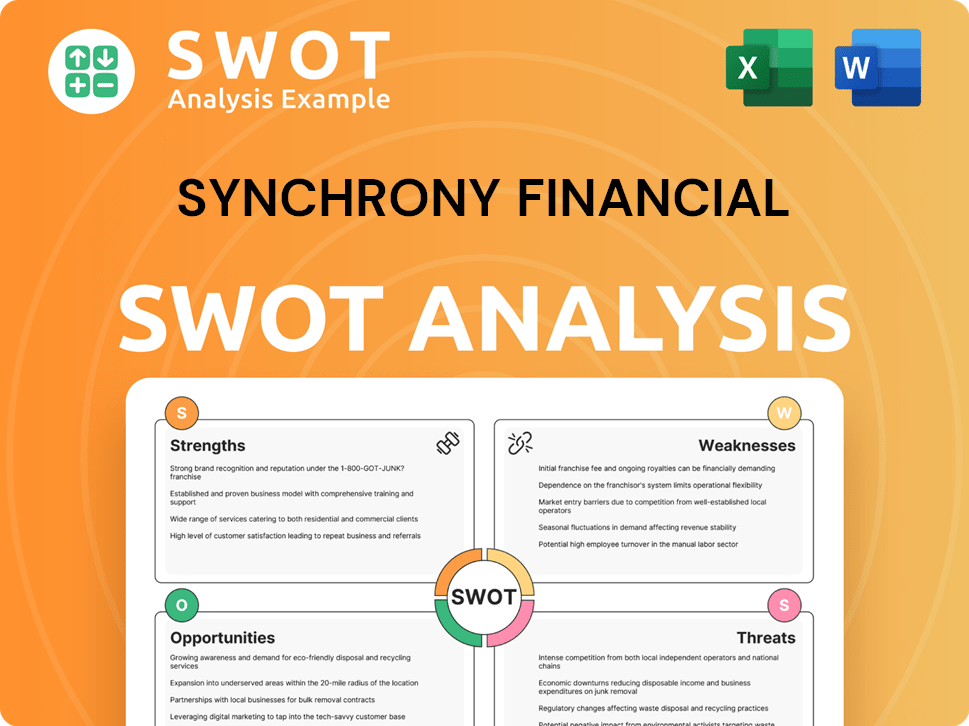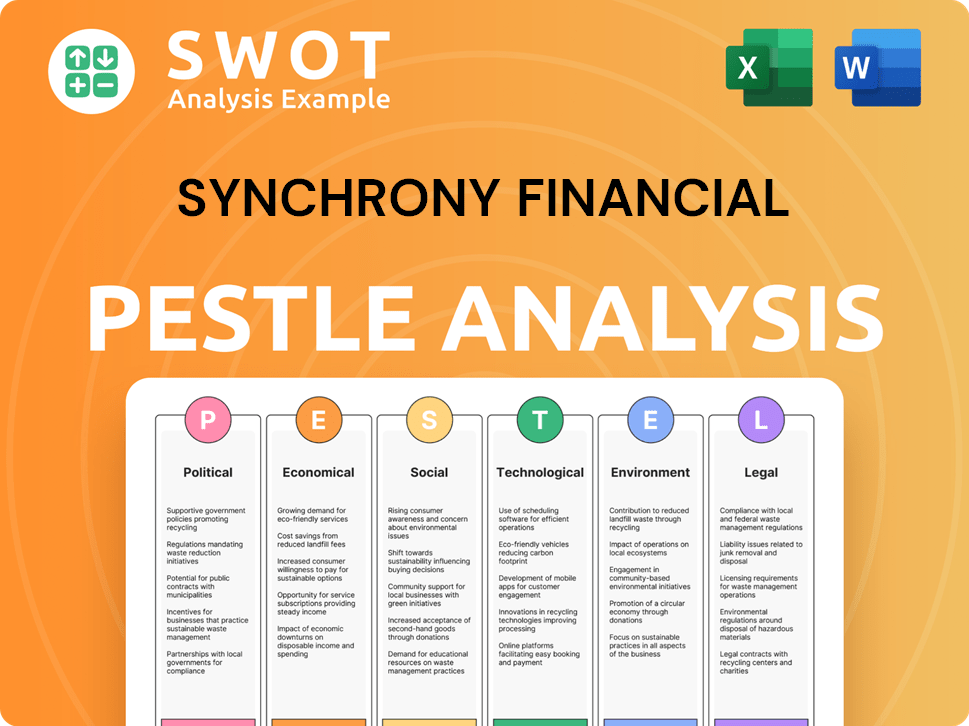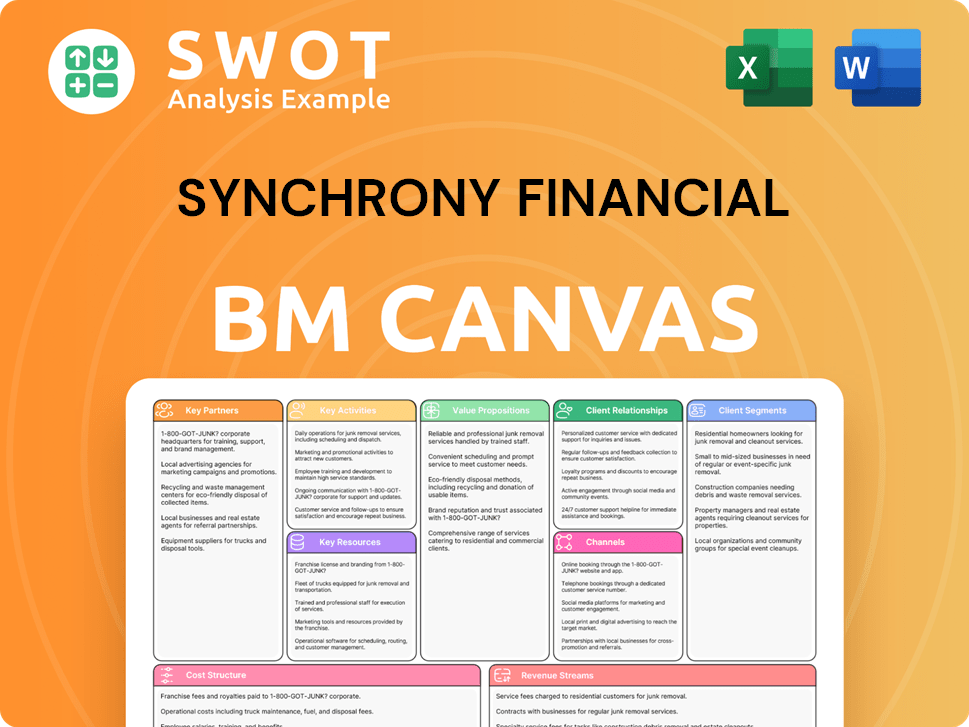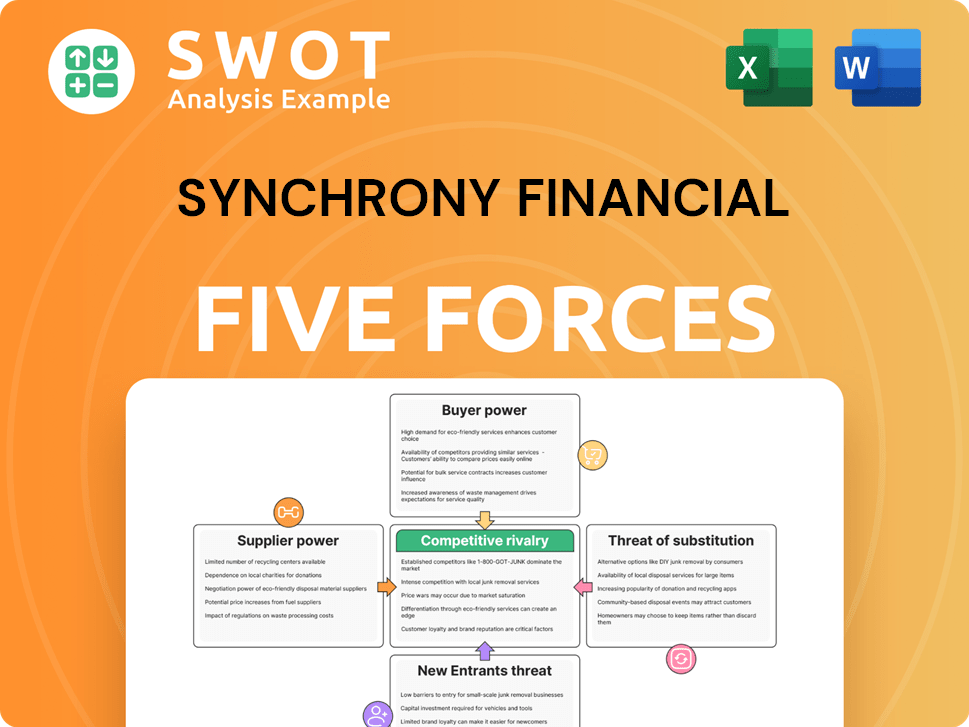Synchrony Financial Bundle
Who Really Calls the Shots at Synchrony Financial?
Understanding the Synchrony Financial SWOT Analysis is crucial to grasping its market position, but have you ever wondered who truly steers this financial services company? The ownership structure of Synchrony Financial, a leading player in the credit card industry, is a dynamic story of transformation and strategic evolution. From its origins to its current status, the journey of Synchrony Financial's ownership reveals much about its corporate identity and future prospects.

The evolution of Synchrony Financial's ownership, from its roots with GE Capital to its current independent status, is a key aspect of its success. Knowing the Synchrony Financial owner helps investors and stakeholders understand the company's strategic direction and financial health. This exploration will delve into the intricacies of Synchrony ownership, examining how major shareholders and public markets influence this financial services company, including Synchrony Bank, and its relationship with General Electric.
Who Founded Synchrony Financial?
The story of Synchrony Financial begins within the financial services arm of General Electric, GE Capital. Incorporated in Delaware in 2003 as GE Capital Retail Finance Corporation, the company's operational roots were firmly planted within GE's structure. This initial phase set the stage for its eventual emergence as an independent entity.
Early ownership of Synchrony Financial was entirely vested in General Electric. As a spin-off from GE Capital, the company did not have traditional founders or angel investors. The strategic direction and financial backing came directly from GE, making it the primary owner during its formative years.
Prior to its initial public offering (IPO), Synchrony Bank, a wholly-owned subsidiary, operated as GE Capital Retail Bank. The shift to Synchrony Bank, which occurred shortly before the IPO in June 2014, signaled its transition towards independence. This period was characterized by GE's control, with decisions and financial support originating from the parent company. There were no early agreements like vesting schedules or buy-sell clauses with external founders, as the ownership was internal to GE. Any initial 'ownership disputes' would have been internal corporate restructuring discussions within General Electric. The founding team's vision, at this stage, was intrinsically linked to GE's broader financial services strategy, focusing on co-branded credit products.
Synchrony Financial's inception was as a part of GE Capital, not a standalone startup. This means there were no individual founders in the traditional sense.
Initially, GE held complete ownership of Synchrony Financial. This structure was typical for a spin-off from a larger corporation.
Before going public, the company operated as GE Capital Retail Bank. The name change to Synchrony Bank marked its preparation for independence.
The early focus was on co-branded credit products, aligning with GE's financial services strategy. The company's strategy was formed within GE.
There were no external founders or early investors, and ownership was entirely internal to GE. This structure was a result of being a spin-off.
The transition to Synchrony Bank signaled the beginning of its journey towards becoming a separate, publicly traded company.
The initial ownership structure of Synchrony Financial, therefore, was a direct consequence of its origins within GE Capital. The company's focus on co-branded credit products and its operational framework were all shaped by its parent company. For more details on the target market of Synchrony Financial, you can read more in this article. In 2024, the company's total assets were reported at approximately $98 billion, a testament to its growth since its inception as a spin-off from GE. The company's transformation from a division within GE to a publicly traded financial services company reflects a significant shift in ownership and strategic direction.
Synchrony Financial SWOT Analysis
- Complete SWOT Breakdown
- Fully Customizable
- Editable in Excel & Word
- Professional Formatting
- Investor-Ready Format

How Has Synchrony Financial’s Ownership Changed Over Time?
The ownership of Synchrony Financial, a major financial services company, underwent a significant transformation with its Initial Public Offering (IPO) in July 2014. This event marked its transition from a subsidiary of GE Capital to a publicly traded entity listed on the New York Stock Exchange (NYSE: SYF). The IPO was a pivotal moment, allowing Synchrony to operate independently and attract a diverse range of investors.
During the IPO, Synchrony raised approximately $2.88 billion by issuing 125 million shares of common stock, representing about 15.1% of the total shares outstanding immediately after the IPO. This capital infusion was crucial for its future growth and expansion in the financial sector. Since its IPO, Synchrony has grown substantially, with total assets reaching US$119.5 billion in 2024 and total equity at US$16.58 billion, demonstrating its financial strength and market position.
| Key Event | Date | Impact on Ownership |
|---|---|---|
| Initial Public Offering (IPO) | July 2014 | Transitioned from a subsidiary of GE Capital to a publicly traded company. Raised $2.88 billion. |
| Subsequent Shareholder Activity | Ongoing | Institutional investors and public shareholders influence company strategy and governance. |
| Recent Financial Performance | 2024 | Total assets increased to US$119.5 billion, with total equity at US$16.58 billion. |
Following the IPO, Synchrony Financial's ownership structure evolved to include a broad base of institutional and public shareholders. As of March 31, 2025, there were 1664 institutional owners and shareholders who had filed 13D/G or 13F forms with the SEC, collectively holding 452,981,229 shares. Key institutional investors as of March 31, 2025, include Vanguard Group Inc. holding 48,420,051 shares, Capital World Investors with 39,384,669 shares, BlackRock, Inc. with 36,062,567 shares, and State Street Corp holding 19,070,361 shares. The shifts in major shareholding reflect the dynamic nature of institutional investment, influencing company strategy and governance.
Synchrony Financial's ownership has evolved significantly since its IPO in 2014, transitioning from a subsidiary of GE Capital to a publicly traded company.
- The IPO raised $2.88 billion, with 15.1% of shares outstanding.
- As of March 31, 2025, there are 1664 institutional owners.
- Vanguard Group Inc., Capital World Investors, BlackRock, Inc., and State Street Corp are major shareholders.
- Changes in shareholding reflect market sentiment and influence company strategy. For more insights, check out the Marketing Strategy of Synchrony Financial.
Synchrony Financial PESTLE Analysis
- Covers All 6 PESTLE Categories
- No Research Needed – Save Hours of Work
- Built by Experts, Trusted by Consultants
- Instant Download, Ready to Use
- 100% Editable, Fully Customizable

Who Sits on Synchrony Financial’s Board?
As of October 1, 2024, the Board of Directors for Synchrony Financial, a leading financial services company, comprises eleven members. Brian Doubles, the President and Chief Executive Officer, also holds a position on the board. The board's composition includes a blend of independent directors and individuals with substantial experience in the financial sector. Daniel Colao was appointed to the board, effective October 1, 2024, and serves on the Risk and Technology Committees. Colao brings over 30 years of industry experience, including his role as CFO and Executive Advisor of GE Capital until June 2021.
The board's structure reflects a focus on robust corporate governance and strategic oversight, crucial for navigating the complexities of the financial industry. This focus is further exemplified by the recent appointment of Daniel Colao, which aims to enhance financial, risk, and strategic expertise within the company.
| Board Member | Title | Committees |
|---|---|---|
| Brian Doubles | President and CEO | Board Member |
| Daniel Colao | Board Member | Risk and Technology |
| Independent Directors | Various | Various |
Synchrony Financial's common stock operates on a one-share-one-vote basis. As of April 16, 2024, there were 401,542,340 shares of common stock outstanding, each entitled to one vote at the Annual Meeting. Holders of common stock do not have cumulative voting rights for director elections. While common stockholders generally have voting rights, holders of preferred stock, such as Series A and Series B depositary shares, have limited voting rights, typically 1/40th of a vote per depositary share under specific circumstances. There are no indications of dual-class shares, golden shares, or founder shares that would grant outsized control to specific individuals or entities beyond the one-share-one-vote principle for common stock. For additional insights into the company's financial structure, you can explore the Revenue Streams & Business Model of Synchrony Financial.
The voting structure at Synchrony Financial is straightforward, with one share of common stock equating to one vote. The board's structure and recent appointments highlight a commitment to strong corporate governance and strategic oversight.
- One-share-one-vote system for common stock.
- Limited voting rights for preferred stock holders.
- Board composition includes independent directors and experienced financial professionals.
- Annual meetings address key matters such as director elections and executive compensation.
Synchrony Financial Business Model Canvas
- Complete 9-Block Business Model Canvas
- Effortlessly Communicate Your Business Strategy
- Investor-Ready BMC Format
- 100% Editable and Customizable
- Clear and Structured Layout

What Recent Changes Have Shaped Synchrony Financial’s Ownership Landscape?
In the past few years, Synchrony Financial has been actively managing its capital, especially through significant share buyback programs. For the full year of 2024, the company returned approximately $1.4 billion to shareholders. In the fourth quarter of 2024, Synchrony Financial returned $100 million to shareholders via share buybacks and paid $97 million in common stock dividends. The buyback yield for Synchrony Financial averaged 10.0% from fiscal years ending December 2020 to 2024, with a peak of 22.4% in December 2022 and a low of 4.6% in December 2024. The company's share repurchase program saw a notable increase, with $605 million in buybacks for the quarter ending March 31, 2025, which is a 101.67% increase compared to the same period last year.
Leadership changes also reflect strategic shifts within the company. Effective August 1, 2024, Maran Nalluswami became EVP, Chief Strategy and Business Development Officer. Courtney Gentleman and Darrell Owens were promoted to EVP & CEO roles for the Diversified & Value and Lifestyle platforms, respectively. Additionally, the company saw changes in its accounting leadership, with David P. Melito retiring as Chief Accounting Officer on July 2, 2024, and Amy Tiliakos taking over as Senior Vice President, Chief Accounting Officer, and Controller on August 1, 2024.
| Metric | Value | Period |
|---|---|---|
| Share Buybacks | $605 million | Quarter ending March 31, 2025 |
| Share Buybacks | $100 million | Q4 2024 |
| Common Stock Dividends | $97 million | Q4 2024 |
| Share Buybacks for the Full Year | $1.4 billion | 2024 |
| Market Capitalization | $22.54 billion | June 6, 2025 |
Industry trends show a rise in institutional ownership within the financial sector, and Synchrony Financial is experiencing this as well. As of Q4 2024, there were 442 institutional investors who added shares of Synchrony Financial to their portfolios, while 351 decreased their positions. The company's market capitalization was $19.41 billion as of September 17, 2024, and $22.54 billion as of June 6, 2025. The company anticipates low single-digit growth in period-end loan receivables for 2025, with a projected net revenue between $15.2 billion and $15.7 billion. For more information about the company's financial performance, you can read more in depth about Synchrony Financial .
The ownership of Synchrony Financial is primarily held by institutional investors. These investors include various financial institutions, investment firms, and other entities that hold significant stakes in the company's stock.
Major shareholders include institutional investors. The specific breakdown of ownership can change over time due to trading activities and investment decisions made by these entities.
Institutional ownership has been a key factor. As of Q4 2024, there were 442 institutional investors who added shares. This indicates a strong level of interest and confidence in the company from the financial community.
Share buybacks are a strategic tool used by the company to return value to shareholders. By repurchasing its own shares, Synchrony Financial reduces the number of outstanding shares, which can increase earnings per share.
Synchrony Financial Porter's Five Forces Analysis
- Covers All 5 Competitive Forces in Detail
- Structured for Consultants, Students, and Founders
- 100% Editable in Microsoft Word & Excel
- Instant Digital Download – Use Immediately
- Compatible with Mac & PC – Fully Unlocked

Related Blogs
- What are Mission Vision & Core Values of Synchrony Financial Company?
- What is Competitive Landscape of Synchrony Financial Company?
- What is Growth Strategy and Future Prospects of Synchrony Financial Company?
- How Does Synchrony Financial Company Work?
- What is Sales and Marketing Strategy of Synchrony Financial Company?
- What is Brief History of Synchrony Financial Company?
- What is Customer Demographics and Target Market of Synchrony Financial Company?
Disclaimer
All information, articles, and product details provided on this website are for general informational and educational purposes only. We do not claim any ownership over, nor do we intend to infringe upon, any trademarks, copyrights, logos, brand names, or other intellectual property mentioned or depicted on this site. Such intellectual property remains the property of its respective owners, and any references here are made solely for identification or informational purposes, without implying any affiliation, endorsement, or partnership.
We make no representations or warranties, express or implied, regarding the accuracy, completeness, or suitability of any content or products presented. Nothing on this website should be construed as legal, tax, investment, financial, medical, or other professional advice. In addition, no part of this site—including articles or product references—constitutes a solicitation, recommendation, endorsement, advertisement, or offer to buy or sell any securities, franchises, or other financial instruments, particularly in jurisdictions where such activity would be unlawful.
All content is of a general nature and may not address the specific circumstances of any individual or entity. It is not a substitute for professional advice or services. Any actions you take based on the information provided here are strictly at your own risk. You accept full responsibility for any decisions or outcomes arising from your use of this website and agree to release us from any liability in connection with your use of, or reliance upon, the content or products found herein.